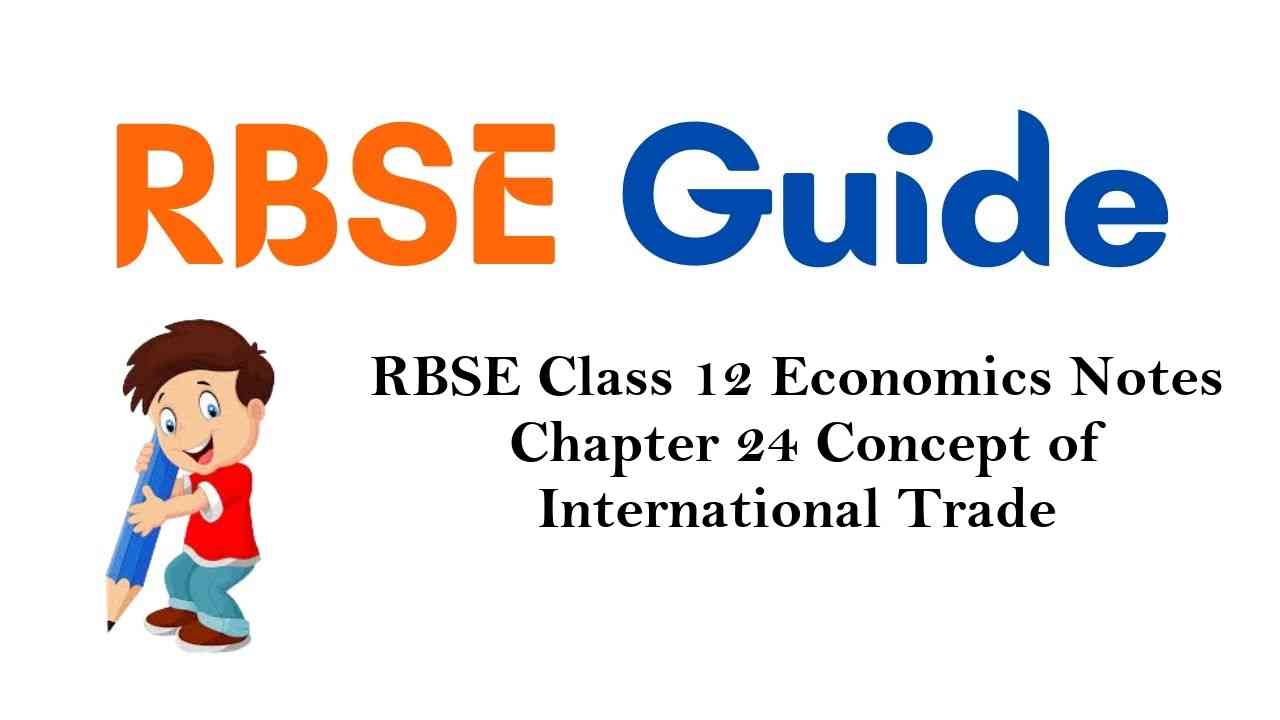Rajasthan Board RBSE Class 12 Economics Notes Chapter 24 Concept of International Trade
Closed economy is such an economy of a country which does not conduct any business and economic transactional relations with other countries.
Open economy is an economy in which mutual exchange of goods and services and trading of financial monetary assets is done with other countries.
Normally, trade means sale and purchase of goods and services.
Internal or domestic trade is limited within the geographical boundaries of the country.
In International trade, goods and services are exchanged among different countries. Trade beyond the geographical boundaries of a countries is called international trade.
Need of international trade can be understood by the following two points :
- All countries are not equally competent to produce all types of goods. Therefore, they have to depend on other countries for obtaining the goods of their need.
- Natural resources of the world are unequally distributed. For example- fertile land, minerals, forest resources and climatic conditions, etc. are unequally distributed.
![]()
International trade provides acess to advanced technology. This transforms developing and backward countries into advanced countries.
Domestic competition also increases due to International trade.
Presently, income from International trade is a large part of Gross National Product.
According to Jacob Viner, “International trade to some extent, is responsible for specialization”.
Balance of Trade is a part of Balance of Payments.
Every country imports and exports goods and services. Out of these, certain items are visible and certain items are invisible.
Visible items means those commodities which are physical and can be seen and measured.
Only visible items are included in the Balance of Trade.
If export of a country is more than its import, then it is termed as favourable Balance of Trade.
If import of a country is more than its export, then it is termed as unfavourable Balance of Trade.
Balance of Payment is a wider concept. In this, both visible and invisible items are included. This payment is made between countries.
Exchange rate is the price of one currency expressed in terms of another currency.
Foreign exchange market is the market where currencies of two or more countries are exchanged.
Exchange rate is determined by the equality of demand and supply of foriegn exchange.
![]()
There are many types of exchange rates. For example, Forward, Spot, Favourable, Unfavourable, Fixed and Flexible exchange rates.
Economists have developed various theories to determine exchange rate. Major ones among them are Demand Supply Theory, Purchasing Power Theory, Balance of Payment theory and Mint Par theory.
Due to change in exchange rates, demand and supply of foreign exchange also changes.
According to Paul Angig, ” Devalution means lowering the authorized parity of currencies”.
Devaluation and revaluation are necessary instruments for the adjustment in Balance of Payment for any country.
Devalution is a process of lowering country’s currency in terms of foreign currency by the government of any country.
Government adopts this measure to reduce the trade deficit, which makes imports costlier and exports cheaper.
Government, through devalution, tries to correct disequilibrium in the balance of Payment.
Revaluation is a policy instrument adopted by the government to adjust the Balance of Payment.
Revaluation helps to increase the value of a country’s currency in terms of foreign currency.
Devaluation and Revaluation both are adopted under Fixed Monetary Exchange Rate System.
![]()
Important Terminology
- Domestic trade : Trade in various spheres within the geographical boundaries of the country.
- International trade : Trade outside the geographical boundaries of a country with other countries.
- Closed economy : It is an economy of the country which does not have business and monetary transactional relations with other countries.
- Open economy : This is an economy, in which mutual exchange of goods and services and trading of financial monetary assets with other countries is done.
- Visible items : Visible items means those commodities which are physical and can be seen and measured.
- Invisible items : Those items which cannot be seen and measured are called invisible items.
- Balance of payments : Balance of payments is a method to record the payments for international transactions for any country.
- Exchange rate : Exchange rate is the price of one currency expressed in terms of another currency.
- Foreign exchange market: It is the market where currencies of two or more countries are exchanged.
- Devalution : Devalution is a process of lowering the value of a country’s currency in terms of foreign currency.
- Revaluation : Revaluation is a process of increasing the value of a country’s currency in terms of foreign currency.
